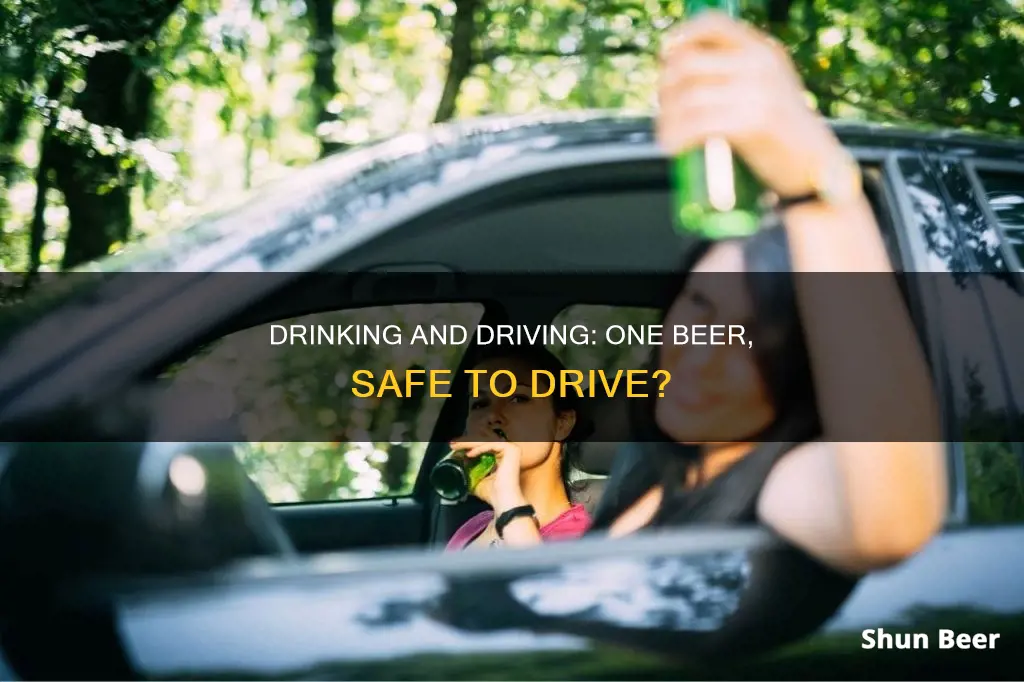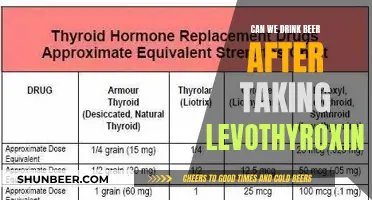
Drinking and driving is a dangerous combination. Even one drink can affect your ability to drive safely. Alcohol impairs your reaction times, coordination, and judgment, making it dangerous to drive. While one drink will usually keep you below the legal limit, it can still impact your driving ability in ways you may not realize. It's important to understand your body's limits and to plan ahead if you know you'll be drinking and driving. The safest option is to avoid drinking altogether if you plan on driving or to arrange alternative transportation.
| Characteristics | Values |
|---|---|
| Is it safe to drive after drinking one beer? | No |
| How long should you wait to drive after drinking? | On average, the human body metabolises one standard alcoholic drink per hour. This is a rate of about 0.015g of alcohol per hour. |
| What is Blood Alcohol Concentration (BAC)? | BAC measures the amount of alcohol in your bloodstream, with legal limits typically set around 0.08% in many places. |
| What is the impact of drinking one beer on driving ability? | Ability to multitask and track moving objects is affected. You may have difficulty driving if you are also trying to listen to directions from your GPS or hold a conversation with a passenger. |
| What are the factors influencing alcohol absorption and metabolism? | Your weight, the amount and type of food you've consumed, and your individual alcohol tolerance all play roles in how quickly your body processes alcohol. |
| What are the consequences of driving under the influence? | The consequences of driving under the influence can be severe, including fines, license suspension, and even jail time. |
What You'll Learn

How does alcohol affect driving ability?
Alcohol is a depressant drug that slows down the activity of the central nervous system, including the brain. This can significantly impact your ability to drive safely. The effects of alcohol on driving ability include:
- Impaired judgement and increased risk-taking: Alcohol can alter judgement and make it difficult to think clearly, make good decisions, and plan ahead. This can lead to increased risk-taking behaviours, which are dangerous when operating a vehicle.
- Reduced concentration and vigilance: Driving requires a lot of concentration, and alcohol can affect your ability to focus on multiple tasks simultaneously, such as steering, maintaining speed, staying in your lane, and avoiding other vehicles.
- Drowsiness: Alcohol can cause relaxation and drowsiness, which may lead to falling asleep at the wheel.
- Slower reaction times: Alcohol slows down reflexes and decreases your ability to react appropriately to hazards on the road. This can result in a delayed response to a roadway hazard.
- Impaired vision: Alcohol can cause blurred vision, slower visual reaction time, and decreased peripheral vision, making it difficult to see obstacles or hazards that are not directly in front of you.
- Loss of coordination: Alcohol affects motor skills, making it harder to control the steering wheel, gas, and brake pedals effectively.
- Difficulty understanding surroundings: Alcohol can make it challenging to understand what is happening around you, leading to difficulty in processing information and making sense of your environment.
- Failure to obey road rules: Alcohol can impact your ability to follow traffic rules and regulations, increasing the risk of accidents.
- Over-confidence: Alcohol can lead to over-confidence, which may result in risk-taking behaviours and a false sense of driving ability.
It is important to note that the effects of alcohol on driving ability can vary from person to person and are influenced by factors such as body weight, biological sex, age, food consumption, and drinking speed. Additionally, the only way to remove alcohol from your system is to allow your body time to process it. Showers, coffee, and fresh air will not reduce your blood alcohol concentration (BAC). The safest option is to refrain from drinking if you plan to drive.
Tums to the Rescue: Beer Sickness Solution?
You may want to see also

Blood Alcohol Concentration (BAC)
The effects of different BAC levels vary. At 0.02% BAC, you may experience an altered mood, relaxation, and a slight loss of judgment. At 0.05% BAC, you may feel uninhibited and have lowered alertness and impaired judgment. At 0.08% BAC, you may have reduced muscle coordination, find it difficult to detect danger, and have impaired judgment and reasoning. As BAC levels increase, so do the negative effects, with BAC levels over 0.4% considered potentially fatal.
The legal blood alcohol limit for driving varies by country and region. In most states in the United States, the legal limit is 0.08% BAC, while in Utah, it is lower at 0.05% BAC. In Europe, the legal limit is typically 0.05 g/dL, and in Abu Dhabi and Canada, BAC levels above 0.0% are not permitted. It's important to note that alcohol can impair driving ability even when below the legal limit, and the safest option is to refrain from driving after consuming any alcohol.
Factors such as the amount and speed of alcohol consumption, food intake, age, weight, and body composition can influence BAC levels. Additionally, BAC calculators and personal breathalysers can provide estimates of BAC levels, but they should not be solely relied on to determine driving ability.
Drinking Beer on New Jersey Beaches: What's Allowed?
You may want to see also

Factors influencing alcohol absorption
There are many factors that influence how the body absorbs and tolerates alcohol. Here are some key considerations:
Biological Sex
Females generally metabolise alcohol differently from males due to physiological differences. Women tend to have lower body water volume, higher body fat percentage, and lower levels of the liver enzyme dehydrogenase, which breaks down alcohol. These factors contribute to higher blood alcohol concentration (BAC) levels in women compared to men, even when consuming the same amount of alcohol. Additionally, women's hormone levels can affect alcohol processing, with BAC levels typically increasing when drinking around the time of menstruation.
Body Weight and Composition
Body weight and composition play a significant role in alcohol absorption. Individuals with lower body weight tend to be more affected by alcohol, as there is less space for alcohol to diffuse in the body. For people of the same weight, those with a lower percentage of body fat will generally have lower BAC levels. This is because alcohol can be distributed throughout the body via the circulatory system, except in bone and fat tissue. As body fat percentage increases, the concentration of alcohol in the lean tissues is proportionally higher.
Food Intake
Consuming food before drinking alcohol is important, as it slows down gastric emptying and reduces alcohol absorption. Eating slows down the processing of alcohol, delaying the peak BAC. The time between eating and drinking also matters—larger meals closer to drinking can lower the peak BAC. While the type of food (carbohydrates, fat, or protein) does not seem to significantly influence BAC, eating foods high in protein is recommended.
Rate of Consumption
The faster alcohol is consumed, the quicker the BAC will rise. Drinking alcohol at a slower pace gives the liver more time to process it, helping to maintain a safe BAC level.
Alcohol Content and Carbonation
Stronger drinks with higher alcohol content will result in higher BAC levels. Additionally, carbonation speeds up alcohol absorption. Alcohol mixed with carbonated beverages, such as tonic water or champagne, will be absorbed more quickly into the bloodstream.
Individual Factors
Other individual factors that can influence alcohol absorption include age, mood, fatigue, stress, and expectations. Age-related changes, such as slowed circulation and lower muscle mass, affect how alcohol is distributed, metabolised, and eliminated in the body. Mood can also play a role, with slight improvements in mood occurring at lower BAC levels and deterioration in mood at higher levels. Fatigue can intensify the effects of alcohol, and strong emotions like anger, fear, and loneliness can hasten impairment. Lastly, numerous studies have shown that a person's expectations of alcohol's effects can influence their experience significantly.
Beer Drinking in Universal Studios: What's Allowed?
You may want to see also

The legalities of drinking and driving
Drinking and driving is a serious issue that can lead to fatal consequences. Even a small amount of alcohol can impair your ability to drive safely, and it is illegal to drive if your judgement, motor skills or coordination have been affected by alcohol. While the legal Blood Alcohol Concentration (BAC) limit in many places is 0.08%, this does not mean it is safe to drive when under this limit.
In the US, the National Highway Traffic Safety Administration reported that in 2018, 1,878 people were killed in alcohol-related crashes involving drivers with BACs below the legal limit. This demonstrates that even a small amount of alcohol can significantly impact driving ability and increase the risk of accidents. Alcohol impairs judgement, slows reaction time, reduces coordination and inhibits the ability to track moving objects. These effects can be more pronounced in certain individuals due to factors such as age, body weight, biological sex, food consumption and medications.
In addition to the legal and safety implications, drinking and driving can also have social consequences. Friends and peers may judge or disapprove of someone who chooses to drive after drinking, even if it is within the legal limit. It is important to plan ahead and arrange alternative transportation if you know you will be consuming alcohol. This could include rideshare apps, public transportation or a designated driver.
The legal consequences of driving under the influence can be severe and vary from fines to license suspension and even jail time. In some places, such as Georgia, there are zero-tolerance laws for drivers under 21 years of age. This means that any positive result on a breath test, regardless of the amount of alcohol consumed, can result in an arrest.
Overall, the risks associated with drinking and driving are significant. It is essential to make informed decisions and practice safe drinking habits to ensure the safety of oneself and others.
Beer, Constipation, and You: The Surprising Truth
You may want to see also

Alternatives to driving after drinking
Drinking and driving is illegal and dangerous. Even if you feel fine after drinking one beer, there are many factors that can affect your body's ability to metabolise alcohol, such as your weight, age, sex, and how much food you've eaten. The only safe option is to avoid getting behind the wheel after drinking any amount of alcohol. Here are some alternatives to driving after drinking:
Leave Your Car at Home
If you leave your car at home, you won't be tempted to drive after drinking. This is a simple but effective way to ensure you don't drink and drive.
Use a Ridesharing App
Ridesharing apps like Uber and Lyft are widely available and offer a convenient and affordable way to get home safely. They are usually cheaper than a taxi and allow you to split the fare with your friends.
Public Transportation
Buses, subways, and rail systems can be a great way to get home if you live in a city. They may not take you directly to your door, but they can get you close enough to walk the rest of the way.
Designate a Sober Driver
If you're going out with friends, see if someone can be the designated driver and stay sober for the night. You can take turns being the designated driver or offer to pay for their gas or dinner as a thank you.
Use a Local Safe Ride Program
There are various sober ride programs across the country, such as "Be My DD" and "SoberRide," that can provide you with a safe ride home. These programs may offer a free cab ride or send a driver to take you home in your own vehicle.
Walk or Spend the Night
If you're close enough, consider walking home or to a nearby hotel. Alternatively, if you're comfortable with the host, ask if you can spend the night at their place.
Plan Ahead
If you know you'll be drinking, make a plan for how you'll get home before you go out. You can arrange for a friend or family member to pick you up, or book a designated driving service that will send a sober driver to take you and your car home.
Drinking Beer in Public: France's Laws Explained
You may want to see also
Frequently asked questions
No, it is not safe to drive after drinking any amount of alcohol. Even one drink can affect your ability to drive safely.
Alcohol impairs your reaction times, coordination, and judgment, making it dangerous to drive. Even if you are under the legal Blood Alcohol Concentration (BAC) limit, your driving ability can still be impaired.
On average, the human body metabolizes one standard alcoholic drink per hour. However, this can vary depending on factors such as weight, food consumption, and individual alcohol tolerance. It's important to wait until you feel sober before driving.
Yes, there are several safe alternatives to driving after drinking. You can take a cab, use a rideshare app, use public transportation, or have a designated driver. Planning ahead and making arrangements before drinking can help ensure a safe ride home.







